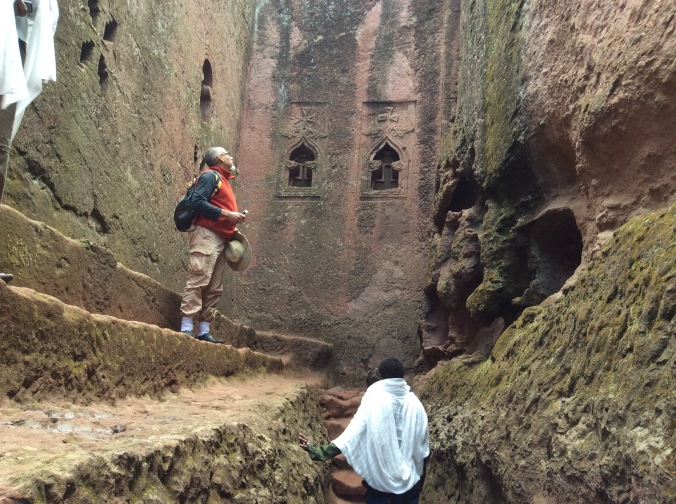This is the first of the monolithic churches we visited. Because the churches were built from the top down and actually cannot be seen until you are very near them, you have to climb down a lot of steps to get to the bottom level from which you can enter into the interior. The “trenches” around them are the same depth as the churches are high because they were carved out of the solid stone. As you look at these photos, you will notice multiple cross designs, including Greek, the type found in Axum, those referred to as Lalibela. Every carving, every painting, every design possesses an explicit symbolic meaning. I wish I had been able to record all the information provided by the guide. This church, Bet Medhane Alem, is the largest of this type. It’s approximate size is 33.7 meters by 23.7 meters with a height of 11.5 meters (109.5 feet by 77 feet with a height of 37.4). All sides have columns.
These churches are not mere tourist attractions. We saw many people walking around, praying, and worshipping. Services are still held here. Carved into some of the “trench” walls opposite the church are tombs. Those buried in these tombs have been removed and their graves now lie on either side of the River Jordan–photos of that later.
The interior decoration includes detailed carvings, elaborate drapes, and paintings.
Certain areas, like this one behind the drapes, only priests can access, mainly because they contain the sacraments. The floors of all the churches are hard rock so all contain coverings of cloth, Persian type rugs, and bamboo. Accessing the interior requires a lot of climbing up and down very worn, slick, stone steps.
While smaller trenches and areas separate this first group of churches from each other, the entire group is surrounded by the deepest, large trench. This is the next church we visited. It lacks outside columns.
At first the sight of swastikas everywhere startled me until I remembered how old these churches are and the original meanings attached to this symbol. Our deacon guide explained that they symbolize everlasting life (the circle of life) and also mentioned its meaning in ancient Hinduism–the continual, everlasting cycle of birth and rebirth.
This is the fertility pool. It is so deep that the priest must be lowered into the water attached to ropes as are the man or woman who wants treatment in this holy water. At one point, someone realized that the pool was no longer as deep as it was originally. When they investigated, they found the pool had been filled with dirt below where it could be seen. When this dirt was excavated, a cache of ancient, holy artifacts were found. They had been buried there to protect them.
Ethiopians wrap themselves in white not just to go to church, but in general. I constantly marveled how they keep these garments so incredibly white in spite of dirt and rain and walking through mud everywhere. The person on the right is our guide, a deacon in the Ethiopian Orthodox Church. He knows the meaning of every carving, every painting, every symbol. The extent of information explained was not only detailed but extensive.
Only some of the churches possess paintings on the walls as well as carvings. The wise men, Mary, everyone looks Ethiopian at least to some extent.
Notice the Star of David. This symbol is everywhere because the Ethiopians believe they are descendants of Solomon and Sheba. As a consequence, the paintings, carvings, all the symbols reflect not only the New Testament but also the Old Testament.
Every church has this curtain behind which only a priest can go. Every church has a copy of the Ark of the Covenant. They believe the original was taken by Menelik I, the son of Solomon and Sheba, to its current location in Axum in a special treasury next to the Church of Saint Mary of Zion. It has been safely kept there through the millennia.
Protective roofs cover some of the churches. The guide explained that the hardness of the basalt varies. Because some of the stone is softer, churches carved out of this softer stone had begun to deteriorate. The coverings protect and preserve them.
To get from church to church in this first group of churches, usually we walked through these trenches. To reach the actual church entrances requires climbing up steps. These trenches enable water drainage into the River Jordan during the rainy season. The floor of the churches remain above the water.
Walking through these churches kept me in a constant state of awe. They were built more than 800 years ago without modern tools. And there are eleven of them all here, carved out of solid stone.
St. George and the Dragon hold a prominent place in Ethiopian Orthodox symbolism. The dragon represents paganism. St. George slated the dragon.
We left this group of churches, climbing out from this trench and headed to one of the most photographed.
We encountered two walking funeral processions complete with chanting. I took no photos because it seemed disrespectful.






















Wow! I’ve never before seen pictures of these churches or anything like. Thank you so much for sharing!
Sharon, I am so glad you like this. There are more churches and the next post will cover them.